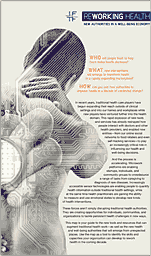Future Now
The IFTF Blog
Reworking Health: Automating Media Therapy
Programming media streams to improve health outcomes
On an intuitive level, we all recognize that art can impact our well-being. Music, movies, games, paintings, and other kinds of media can make us feel joy, pain, and fear. But recent research suggests art can be used in medicine in very specific, targeted ways.
One of the early places we see this happening is in the Music & Memory program. A few years back, a retirement home took inspiration from neuroscience research and started giving dementia patients iPods with personalized playlists of music from their past. The main idea is that music taps deep memories that haven’t been lost to dementia, and when patients hear it, many of them spring to life and they’re able to be present and hold a conversation in a way they weren’t before. This program was so successful that they started implementing it in other homes, and today, it’s being used at more than 140 facilities throughout the U.S. and Canada.
 Another key place we’re seeing media used therapeutically is in pediatric medicine. For instance, music has been found to reduce pain in burn victims and distress in children undergoing chemo. Researchers studying music’s effects on premature infants have even found that live music provided by a certified music therapist can increase a premature infant’s capacity to feed, sleep, and to self-regulate.
Another key place we’re seeing media used therapeutically is in pediatric medicine. For instance, music has been found to reduce pain in burn victims and distress in children undergoing chemo. Researchers studying music’s effects on premature infants have even found that live music provided by a certified music therapist can increase a premature infant’s capacity to feed, sleep, and to self-regulate.
This is all today. In the future, though, these kinds of interventions are likely to get more sophisticated. Going forward, we’ll be better able to measure both the precise therapeutic benefits of music and other media for different conditions, as well as what’s going on in our bodies and in our minds at a given moment. As these two kinds of data become more robust, we’ll see increasing efforts to combine them to automatically bring people the media they need for their health, when they need it.
Outside of medicine, we already see early attempts to do this. Apps like Songza and Jog.Fm, for instance, recommend music to joggers based on their heart rate. But as these systems get more advanced, you could see a future in which we have automated systems that recommend all sorts of media to us for many different health and well-being effects.
Were this to happen, streaming music and movie services, as well as video game companies, would have an interesting place in the well-being economy with data-driven playlists, movie recommendations and even gaming experiences designed for specific health and well-being events and outcomes.
While many people see a rise of computational power and quantification as antagonistic towards art, in these cases, it could make the value of art more apparent, and make it’s use acceptable to entities that need metrics to justify their usage. (Of course, there’s a genuine risk of trying to quantify things that are by nature unquantifiable and subjective, such as the value or merit of art, so being clear about the limits of our measurement capabilities, and therefore their usages, is very important). But overall, this measurement capacity could enable traditional players in health and well-being, like governments, insurers, and providers, to bring art into health in some very meaningful ways.
In our 2013 Health Horizons research, Reworking Health, we examined four emerging sources of authority—computation, narratives, networks, and ambience—that will fundamentally transform who we trust and what interventions will be available in a rapidly expanding health and well-being marketplace.
This series of blog posts dives into the map's forecasts to reveal new opportunities and help you imagine what skills and capacities you or your organization can develop to rework health in the coming decade:
- Amplifying the Positive
- Commoditizing Bodywork
- Optimizing the Care Effect
- Uncovering Empowering Identities
- Coordinating Caring Communities
- Calibrating Pain
About IFTF's Health Horizons Program
- Contact Dawn Alva at dalva@iftf.org or 650-233-9585



